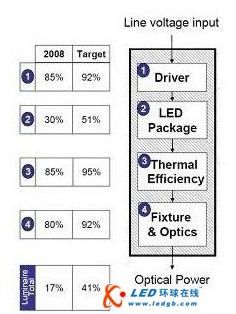LED driver general requirements
Driving LEDs faces many challenges. For example, the forward voltage will change with temperature and current. The LED forward voltage of different individuals, different batches, and different suppliers will also vary. In addition, the color of the LED The point will also drift as the current and temperature change.
In addition, multiple LEDs are often used in applications, which involves the arrangement of multiple LEDs. Among the various arrangements, it is preferred to drive a single string of LEDs in series because this method provides excellent current matching performance regardless of how the forward voltage changes and how the output voltage (Vout) "drifts".
Power factor correction
Power Factor Correction (PFC) is mandatory for any power class specified by the US Department of Energy (DOE) ENERGY STAR Solid State Lighting (SSL) specification. This standard applies to a range of specific products, such as recessed lights, cabinet lights and table lamps, where the LED driver power factor for residential applications must be greater than 0.7, and for commercial applications greater than 0.9; however, this standard is a voluntary standard. The European Union's IEC61000-3-2 harmonic content standard specifies the total harmonic distortion performance of lighting applications with power greater than 25W. The maximum limit is equivalent to total harmonic distortion (THD) of 0.94.
While not all countries absolutely mandate improved power factor in lighting applications, some applications may have this requirement, such as utilities that promote commercial applications of products with high power factor in utilities, and utilities. When an organization purchases/maintains a street light, it can also decide whether it is required to have a high power factor (usually >0.95+) according to their wishes.

Figure 1: Schematic diagram of the application circuit of active PFC
PFC technology includes passive PFC and active PFC. Passive PFC solutions are bulky and require additional components to better change the current waveform to achieve a power factor of about 0.8 or higher. Among them, in lower power applications of less than 5W to 40W, almost the standard choice of flyback topology requires only passive components and minor circuit modifications to achieve a power factor greater than 0.7.
The active PFC (see Figure 1) is typically added to the circuit as a dedicated power conversion section to change the input current waveform. Active PFCs typically provide boost, with a wide input range of 100 to 277Vac and a PFC output voltage range of 450 to 480Vdc. If properly designed for PFC sections, 91% to 95% energy efficiency can be achieved. However, with the addition of active PFC, a dedicated DC-DC conversion is still required to provide current regulation.
Energy efficiency problem
The energy efficiency of LED lighting applications needs to be considered in conjunction with power output. The US Energy Star solid-state lighting specification specifies the energy efficiency of the lighting fixture level, but does not address the energy efficiency requirements of individual LED drivers. As mentioned earlier, LED applications using AC-DC power supplies can use a two-stage distributed topology, so they may be powered by an external AC-DC adapter.
The "Energy Star" does include specifications for single-output external power supplies. The 2.0 version of the external power supply specification came into effect in November 2008, requiring a minimum energy efficiency of 87% in the standard operating mode and a minimum energy efficiency of 86 in the low-voltage operating mode. %; In this specification, PFC is required when the power is greater than 100W.

Figure 2: Energy efficiency research and development goals for LED lighting fixtures proposed by the US Department of Energy in the fall of 2008
In LED applications using AC-DC power supplies, providing higher AC-DC conversion energy efficiency involves trade-offs between cost, size, performance specifications, and energy efficiency. For example, using higher quality components and lower on-resistance (RDSon) can reduce losses and improve energy efficiency; lowering the switching frequency generally improves energy efficiency, but increases system size. New topologies such as resonance provide greater energy efficiency, but also increase the complexity of the design and components. If we limit the design to a narrower power and voltage range, it can help optimize energy efficiency.
Drive standard
The LED driver itself is also evolving, with a focus on further energy efficiency, increased functionality and power density. The US "Energy Star" solid-state lighting specification proposes energy efficiency limits at the lighting fixture level, involving specific product requirements including power factor. The requirements of the European Union's IEC61347-2-13 (5/2006) standard for LED modules powered by DC or AC include:
Maximum safety extra low voltage (SELV) working output voltage ≤ 25Vrms (35.3Vdc)
"appropriate" / safe work under different fault conditions
No smoke or flammable when it fails
In addition, the ANSIC82.xxx LED driver specification is still under development. In terms of safety, it is required to comply with UL, CSA and other standards, such as UL1310 (Class 2), UL60950, UL1012. In addition, LED lighting design also involves product life cycle and reliability issues.
Various models of Yamaha Nozzles, providing product images and partner number for each Yamaha Nozzle. We specialized in Yamaha Nozzle for 11 years. Our Yamaha Nozzles in high quality, low cost. Looking forward to your cooperation!
Yamaha Nozzle Features:
A: Special nozzle forming an organic whole, to ensure its precision.
B: Nozzle inner hole polished by imported precision equipment, main body is made of imported steel which be dealt with heat treatment, good abrasion resistance.
C: Nozzle head made of tungsten steel, drill steel, ceramics and other materials, durable and never be white.
D: Import spring, keep a good elasticity over 6 months.
Yamaha Nozzle
Yamaha Nozzle,Smt Nozzle For Yamaha,Nozzle For Yamaha Chd275,Yamaha Top Smt Nozzle
Guangdong Juguangheng Automation Equipment Co.,Ltd. , http://www.smtsupplier.net